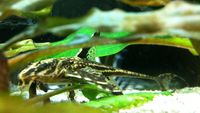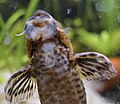Difference between revisions of "Rineloricaria lanceolata"
From The Aquarium Wiki
(→General care) |
|||
| (5 intermediate revisions by one other user not shown) | |||
| Line 38: | Line 38: | ||
==General care== | ==General care== | ||
| − | : These fish can reach a potential size of 12 cm/4.7 inches. They are slightly | + | : These fish can reach a potential size of 12 cm/4.7 inches. They are slightly smaller than the more popular species of [[Bristlenose Catfish]] / Ancistrus, however move considerably less. Despite this, they are still interesting fish and can be kept in aquariums as small as 15 gallons. They will eat frozen foods, chopped earthworm and catfish tablets. Pellet foods may also be eaten. They require driftwood or bogwood in order to keep the pH around 6.5. They are more active with subdued lighting. Floating plants are recommended. |
| + | |||
| + | ===Behavior=== | ||
| + | These fish are generally not very active. They will, however shuffle along the ground using their fins and mouth. Do not keep these fish with boisterous fish (puffers, tiger barbs, loaches). Make sure they get enough food, as they can be out competed. | ||
==Feeding== | ==Feeding== | ||
| Line 46: | Line 49: | ||
:Sexing is very straightforward in this species. The male has a much broader head than the female and his cheeks are densely covered with odontodes ("whiskers"). | :Sexing is very straightforward in this species. The male has a much broader head than the female and his cheeks are densely covered with odontodes ("whiskers"). | ||
| − | + | == Breeding == | |
| + | :Like with bristlenose catfish, breeding whiptails requires little or no interference on the part of the aquarist. They spawn on rocks, wood or even aquarium glass! Ideally buy three males and three females in a large tank. The males will mark out territories and the females will lay eggs. | ||
| + | |||
| + | ===Breeding Habitat=== | ||
| + | Wood, rocks, pvc tubing and caves will help with breeding. So will plants. | ||
| + | |||
{{Categories | {{Categories | ||
|Category=Fish, Fish (Freshwater), Catfish, Plecos, Small Plecos | |Category=Fish, Fish (Freshwater), Catfish, Plecos, Small Plecos | ||
Latest revision as of 07:30, 16 April 2021
Lanceolate Whiptail Catfish
Rineloricaria lanceolata
57 Litres (15 US G.)
7.6-10.2cm (3-4 ")
Freshwater
6.0 - 8.0
25 -28 °C (77-82.4°F)
5-19 °d
1:1 M:F
8-12 years
Family
Loricariidae
| You can contribute to the Aquarium Wiki by expanding this article. Dont be shy!. |
Contents
Additional names
- Lanceolate Whiptail Catfish, Whiptail Catfish
Additional scientific names
- Hemiloricaria lanceolata, Loricaria lanceolata
General care[edit]
- These fish can reach a potential size of 12 cm/4.7 inches. They are slightly smaller than the more popular species of Bristlenose Catfish / Ancistrus, however move considerably less. Despite this, they are still interesting fish and can be kept in aquariums as small as 15 gallons. They will eat frozen foods, chopped earthworm and catfish tablets. Pellet foods may also be eaten. They require driftwood or bogwood in order to keep the pH around 6.5. They are more active with subdued lighting. Floating plants are recommended.
Behavior[edit]
These fish are generally not very active. They will, however shuffle along the ground using their fins and mouth. Do not keep these fish with boisterous fish (puffers, tiger barbs, loaches). Make sure they get enough food, as they can be out competed.
Feeding[edit]
- They will eat frozen foods, chopped earthworm and catfish tablets. Pellet foods may also be eaten.
Sexing[edit]
- Sexing is very straightforward in this species. The male has a much broader head than the female and his cheeks are densely covered with odontodes ("whiskers").
Breeding[edit]
- Like with bristlenose catfish, breeding whiptails requires little or no interference on the part of the aquarist. They spawn on rocks, wood or even aquarium glass! Ideally buy three males and three females in a large tank. The males will mark out territories and the females will lay eggs.
Breeding Habitat[edit]
Wood, rocks, pvc tubing and caves will help with breeding. So will plants.
Pictures[edit]
External links[edit]
- Fishbase (Mirrors:
 )
)


